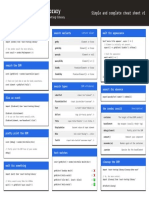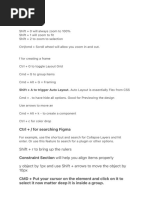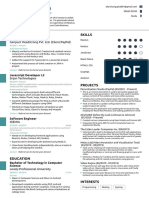0 ratings0% found this document useful (0 votes)
60 viewsLearn ASP - NET: ASP - NET: Middleware Cheatsheet
The document discusses middleware in ASP.NET, including how middleware components are added and ordered in the pipeline, how to access built-in and add custom middleware, and how different middleware components like UseExceptionHandler, UseHttpsRedirection, and UseStaticFiles work.
Uploaded by
Karthik BachawalaCopyright
© © All Rights Reserved
Available Formats
Download as PDF, TXT or read online on Scribd
0 ratings0% found this document useful (0 votes)
60 viewsLearn ASP - NET: ASP - NET: Middleware Cheatsheet
The document discusses middleware in ASP.NET, including how middleware components are added and ordered in the pipeline, how to access built-in and add custom middleware, and how different middleware components like UseExceptionHandler, UseHttpsRedirection, and UseStaticFiles work.
Uploaded by
Karthik BachawalaCopyright
© © All Rights Reserved
Available Formats
Download as PDF, TXT or read online on Scribd
You are on page 1/ 4
Cheatsheets / Learn ASP.
NET
ASP.NET: Middleware
Understanding ASP.NET middleware
Web applications use a series of components to
route each HTTP request to its destination and then
return an appropriate response to the user. This
series of components is organized in a pipeline
which is collectively known as middleware.
Adding ASP.NET Middleware Components
The Configure() method is called from the
Startup class. Configure() calls various
app.UseX() methods to build the middleware
pipeline.
Ordering ASP.NET Middleware
Middleware components are called in sequence. The
order in which components are called is very
important and is determined by where the
component appears in the
Startup.Configure() method.
Accessing Built-in ASP.NET Components
The IApplicationBuilder interface public void
de!nes the built-in middleware methods. These
Configure(IApplicationBuilder app,
methods are de!ned by using the format UseX()
with X describing the action performed by the
IWebHostEnvironment env)
method.
Adding custom middleware components
The IApplicationBuilder interface app.Use(async (context, next) => {
provides a generic Use() method which can be
await
used to process custom middleware components
and call the next component in the pipeline. Multiple context.Response.WriteAsync("Custom
middleware components can be chained together middleware!");
with the Use() method, which accepts two await next();
parameters, the HTTP context and the next
middleware component to be called.
});
Adding terminal ASP.NET middleware
IApplicationBuilder.Run() is a app.Run(async (context) => {
terminal middleware component which begins
await
returning the HTTP response. Run() can be
added to the end of the request pipeline since any context.Response.WriteAsync("Terminal
delegates after this component will not be executed. middleware!");
});
Understanding ASP.NET Nested Structure
Proper ordering of middleware components is
important. The middleware request pipeline has a
nested structure where each component can
perform operations before and after the next
component.
Understanding ASP.NET Developer Exception Pages
UseDeveloperExceptionPage() is a
method which provides an exception page
speci!cally designed for developers. The method
should be placed before any middleware
components that are catching exceptions. Some of
the information displayed includes the stack trace,
any query string parameters, cookies, headers, and
routing information.
Understanding ASP.NET UseExceptionHandler Component
The UseExceptionHandler() component if (env.IsDevelopment())
can be used in production environments to catch
app.UseDeveloperExceptionPage();
and log errors and route users to a general error
page without exposing sensitive details about the else
application. The UseExceptionHandler() app.UseExceptionHandler("/Error");
component has several overloads, but a simple way
of using it is to pass in the name of the page (as a
string) that should display if an exception is thrown.
Redirecting Requests with ASP.NET Middleware
The UseHttpsRedirection() method is
the middleware component used to capture HTTP
requests and redirect them to the more secure
HTTPS protocol. Since the redirection is done in the
app con!guration, the user never even has to know
the redirection occurred.
Enabling ASP.NET Endpoints
UseRouting() , must be called to compare the app.UseRouting();
HTTP request with the available endpoints and
app.UseEndpoints(endpoints => {
decide which is the best match.
UseEndpoints() then calls endpoints.MapRazorPages();
MapRazorPages() with a lambda expression });
to register the endpoint, and then executes the
selected delegate that matches our HTTP request.
Understanding the ASP.NET UseStaticFiles Component
Static !les make up an important part of the
application — they often contain HTML, CSS, and
JavaScript code that controls how the application
looks and behaves. The UseStaticFiles()
method is available to ensure static !le content is
rendered alongside the HTML for our web
applications.
Understanding the ASP.NET UseAuthorization Component
The UseAuthorization() component
checks the user’s request against their authorization
status. If the authorization check passes, this
component will pass the request to the next
component in the pipeline. Otherwise, it will short-
circuit the pipeline and either present the user with
a login page or an error.
Save Print Share
You might also like
- Training in Core Java: by - Rahul Karmakar 2813231 ECE (4 Year)No ratings yetTraining in Core Java: by - Rahul Karmakar 2813231 ECE (4 Year)23 pages
- HTML5 Elements: Web Technology Assignment - 1947234100% (2)HTML5 Elements: Web Technology Assignment - 194723458 pages
- Prestashop Module Development: Chapter No. 1 "Creating A New Module"No ratings yetPrestashop Module Development: Chapter No. 1 "Creating A New Module"19 pages
- The Web Analytics Kick Start Guide A Primer On The Fundamentals of Web Analytics (Brent Dykes)No ratings yetThe Web Analytics Kick Start Guide A Primer On The Fundamentals of Web Analytics (Brent Dykes)154 pages
- 1 The Figma Design Tool - Figma Handbook - Design+CodeNo ratings yet1 The Figma Design Tool - Figma Handbook - Design+Code11 pages
- FREE - Building Firestore Powered Ionic Apps 1.0.2 PDFNo ratings yetFREE - Building Firestore Powered Ionic Apps 1.0.2 PDF76 pages
- Move Things With CSS Jhey Tompkins 2020No ratings yetMove Things With CSS Jhey Tompkins 202078 pages
- Tcp/Ip, Troubleshooting & Problem Solving: PracticalNo ratings yetTcp/Ip, Troubleshooting & Problem Solving: Practical2 pages
- How To Be Successful With Salesforce-Winter12No ratings yetHow To Be Successful With Salesforce-Winter123,370 pages
- Learn JavaScript - Arrays Cheatsheet - CodecademyNo ratings yetLearn JavaScript - Arrays Cheatsheet - Codecademy2 pages
- XAML WPF Drawing Brush and Resource DictionaryNo ratings yetXAML WPF Drawing Brush and Resource Dictionary8 pages
- Software Engineering ICT 4103 Assignment - 01No ratings yetSoftware Engineering ICT 4103 Assignment - 0135 pages
- Instant download Pro Spring Security 3rd Edition Masimo Nardone pdf all chapter100% (3)Instant download Pro Spring Security 3rd Edition Masimo Nardone pdf all chapter55 pages
- What Is Middleware: Rick Anderson Steve Smith View or Download Sample CodeNo ratings yetWhat Is Middleware: Rick Anderson Steve Smith View or Download Sample Code10 pages
- Training in Core Java: by - Rahul Karmakar 2813231 ECE (4 Year)Training in Core Java: by - Rahul Karmakar 2813231 ECE (4 Year)
- HTML5 Elements: Web Technology Assignment - 1947234HTML5 Elements: Web Technology Assignment - 1947234
- Prestashop Module Development: Chapter No. 1 "Creating A New Module"Prestashop Module Development: Chapter No. 1 "Creating A New Module"
- The Web Analytics Kick Start Guide A Primer On The Fundamentals of Web Analytics (Brent Dykes)The Web Analytics Kick Start Guide A Primer On The Fundamentals of Web Analytics (Brent Dykes)
- 1 The Figma Design Tool - Figma Handbook - Design+Code1 The Figma Design Tool - Figma Handbook - Design+Code
- FREE - Building Firestore Powered Ionic Apps 1.0.2 PDFFREE - Building Firestore Powered Ionic Apps 1.0.2 PDF
- Tcp/Ip, Troubleshooting & Problem Solving: PracticalTcp/Ip, Troubleshooting & Problem Solving: Practical
- Instant download Pro Spring Security 3rd Edition Masimo Nardone pdf all chapterInstant download Pro Spring Security 3rd Edition Masimo Nardone pdf all chapter
- What Is Middleware: Rick Anderson Steve Smith View or Download Sample CodeWhat Is Middleware: Rick Anderson Steve Smith View or Download Sample Code



























































